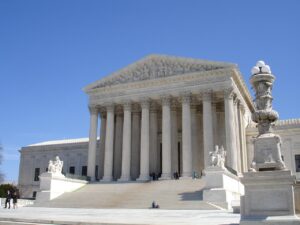
The U.S. Supreme Court (Photo by David Lat).
Last Friday the Supreme Court issued another so-called shadow docket ruling in South Bay United Pentecostal Church v. Newsom. In a split decision, the Supreme Court enjoined enforcement of California’s total ban on indoor worship services in areas of the state with the highest rate of COVID-19 infection (Tier I). Yet, the court left in place California’s 25% capacity limits, as well as the ban on singing and chanting in indoor church services in Tier I designated areas. Although striking down the ban on churches was not surprising for anyone who has been paying attention, given the recent decision in Roman Catholic Diocese of Brooklyn. It was still rather shocking to see many of the Justices double down on analysis that has received so much criticism, including from prominent conservative legal voices.
First, let’s get into the necessary legal background. The basis for the majority’s analysis in both South Bay and Roman Catholic is built upon what’s called the “most favored nation” theory of religious free exercise. Prior to the Roman Catholic decision, however, the general understanding of the theory was that strict scrutiny applied wherever the government was regulating religious exercise while a comparable secular activity was being exempted. To illustrate the application of this theory in these pandemic times, if indoor church services were being banned but movie theaters (where people also are assembled indoors together for longer periods) were not, strict scrutiny would apply.
But the application of the most favored nation theory by the Supreme Court starting in Roman Catholic had a very important difference. The majority dropped the element that the activities being compared must be, well, comparable. In Roman Catholic, the majority chose retail stores as the comparison group for indoor church services. The problem is, the two are not really comparable because people don’t linger for an hour or more next to the same people in retail stores and they don’t engage in group singing. As I wrote about before, a federal district court judge (following California’s state epidemiologist) identified the problem with comparing churches to retail stores noting that unlike indoor religious services:
[R]etail shopping centers, hotels, laundromats, and liquor stores pose a lower risk of transmission than indoor religious gatherings. Staying at a hotel, doing laundry at a laundromat and retail shopping may bring people into relative closeness, but none of these activities would require them to remain in proximity for longer than a brief interlude. Because viral load matters, standing next to someone infected with Covid-19 for fifteen minutes is much less dangerous than standing next to someone infected with Covid-19 for one hour.
By dropping the comparable activity element of the most favored nation theory, the Roman Catholic decision received a lot criticism. Including from one of the staunchest advocates of the theory, University of Virginia Law Professor Douglas Laycock. When discussing the Roman Catholic decision (beginning at 12:15) Laycock noted that churches in New York were in fact being treated better than comparable secular activities (like movie theaters and sporting events), but the court “had to find discrimination somehow. And so they found it by comparing churches to grocery stores. It’s kind of silly.” Yes. It is kind of silly. Or at least it would be silly if the consequences were not so dire in a deadly pandemic.
In last Friday’s South Bay decision, Justice Gorsuch used the comparison of indoor churches to Hollywood singing competitions stating that “if Hollywood may host a studio audience or film a singing competition while not a single soul may enter California’s churches, synagogues, and mosques, something has gone seriously awry.” This attempt at comparison, however, was also called into question. This time by other conservative members on the court. Justice Barrett, joined by Justice Kavanaugh, wrote separately to note that the record was “unclear whether the singing ban applied across the board.”

How 8am LawPay Takes The Sting Out Of Legal Billing
Getting paid can be an arduous task. You should make it as easy on yourself and your clients as possible.
But other problems exist with the most favored nation theory outside of the comparison element. Think about it. What other constitutional right is analyzed under a standard where the extent to which the right is burdened is not a factor at all, but rather, all that seems to matter to the Supreme Court is whether the state values another interest more than the exercise of the right? Why should free exercise, and only free exercise receive such a favorable standard while claims of racial discrimination must suffer under an undeniably more difficult burden to satisfy?
Or think about it this way. Prior to Barrett’s ascension to the Supreme Court, the Chief Justice had joined the liberal members in denying to hear a challenge to Nevada’s COVID-19 restrictions. This was considered to be an outrage to the other conservative justices because Nevada was regulating casinos differently than all other private activities, including churches. But what if a state didn’t single out casinos and simply applied the same public health measures Nevada was imposing on everyone? Under the most favored nation theory, the Nevada public health measures would be struck down, but the exact same public health measures in the next state over would be upheld.
Does that seem rational?
Keep in mind, Nevada has a powerful and compelling interest to both regulate casinos more strictly but also to keep them open. Casinos represent virtually the entirety of Nevada’s economy, supporting hundreds of thousands of jobs. If casinos were effectively banned, Nevada’s economy and the ability to fund a functional state government would collapse. The same compelling interest cannot be said for churches which can still operate essentially the same remotely or outdoors under Nevada’s public health measures.
I can keep going. Many states exempt police and first responders from traffic laws. Now, if you or I try to challenge such exemptions because we don’t get the same treatment we are going to get laughed out of court, likely under some form of rational basis review, rightly so. But if a church challenges this exemption, well, they would be entitled to strict scrutiny under a most favored nation theory.
The fact is nothing about this Supreme Court’s religious liberty doctrine reflects equality or liberty for all — although the free exercise clause has been continually expanded under the most favored nation theory, and states have expanded free exercise protection beyond the First Amendment’s scope. The other half of the First Amendment’s guarantee of religious liberty, the establishment clause, has been continually restricted. The result is a legal reality where religious citizens can be exempt from criminal liability whereas a nonbeliever would not, even if both committed the same act. And while states can expand free exercise liberty, they cannot expand establishment clause liberty. This is not equality or treating the religious liberty clauses with equal respect; it is in fact the epitome of inequality.
What’s more, the consequences of this inequality and legal favoritism of religion are dire, outside the context of even this deadly pandemic. This country is now faced with a unique situation. Where for the first time a large percentage of nonbelievers are living alongside a religious population. For the Supreme Court to create a doctrine that favors one and disfavors the other can only result in widening the already sharp divide.
 Tyler Broker’s work has been published in the Gonzaga Law Review, the Albany Law Review, and is forthcoming in the University of Memphis Law Review. Feel free to email him or follow him on Twitter to discuss his column.
Tyler Broker’s work has been published in the Gonzaga Law Review, the Albany Law Review, and is forthcoming in the University of Memphis Law Review. Feel free to email him or follow him on Twitter to discuss his column.
